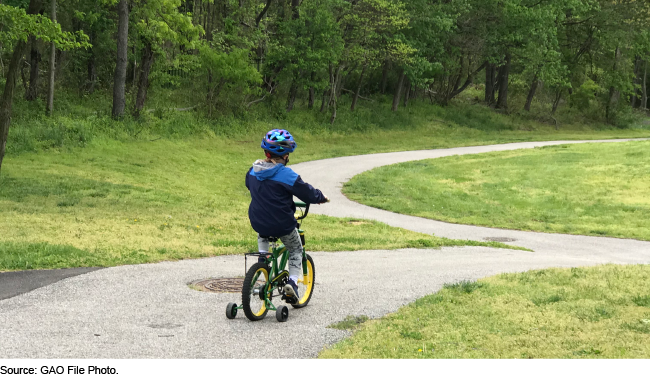Child Welfare: Pandemic Posed Challenges, but also Created Opportunities for Agencies to Enhance Future Operations
Fast Facts
This report examines how child welfare agencies responded to the COVID-19 pandemic. We surveyed administrators in all 50 states, D.C., Puerto Rico, and the U.S. Virgin Islands.
Officials we interviewed in 15 agencies reported declines in child abuse reports and concerns about unreported cases, as children had less contact with mandated reporters such as teachers. The pandemic also delayed child welfare hearings.
Aided by federal funds, officials in most areas reported providing assistance such as formula and diapers. They also expanded and may continue virtual services, such as for visits between children in foster care and biological families.

Highlights
What GAO Found
Child welfare officials GAO interviewed in five selected states reported challenges affecting both child protective and foster care services during the pandemic in 2020-2021. Officials interviewed in all five state and 10 local child welfare agencies noted concerns about unreported child abuse and neglect, as children had less contact with mandated reporters such as teachers and doctors due to school and office closures. Officials also discussed challenges initially accessing technology and personal protective equipment needed to reduce health risks to staff and families. In addition, officials in four state and all 10 local agencies discussed delays in child welfare hearings because of court closures, which can affect when children can reunify with their parents or be adopted.
Aided by federal funding and other supports provided by the Department of Health and Human Services (HHS), child welfare agencies reported navigating pandemic challenges by increasing assistance to families and providing virtual services. HHS distributed CARES Act funds in amounts ranging from $15,686 to $4,690,717 to states for certain child welfare services, and provided various flexibilities to allow child welfare agencies to adapt their work. Child welfare officials in 35 of the 53 states GAO surveyed reported that they had reached out to support families who had previously been in contact with the agency to offer assistance, such as with food, diapers, and formula. Officials in GAO's survey also reported that most agencies in their state had implemented various forms of virtual services. This included facilitating visits for children in foster care to spend time with their biological families (52 states), participating in court hearings (47 states), and providing virtual health services (35 states).
Child welfare officials in the 53 states GAO surveyed reported that they may continue providing virtual services (see figure), strengthening stakeholder partnerships, and updating disaster plans after the pandemic ends. Officials interviewed in all five state and 10 local agencies discussed benefits they observed when providing virtual services, such as increased options for children in foster care to spend time with their biological families (e.g., virtual dinners and bedtime stories). In addition, these officials discussed considerations for determining when virtual services are appropriate. Officials in all of the state and local agencies also discussed the importance of stakeholder communication and partnerships, such as with community organizations and health and education departments, which allowed them to quickly share information and serve families. Lastly, officials in all of these agencies discussed being unprepared for the pandemic. Officials in several agencies said they needed to update their disaster plans, for example, to include health safety guidance.
Virtual Services Child Welfare Agencies May Continue after the COVID-19 Pandemic

Why GAO Did This Study
The Coronavirus Disease 2019 (COVID-19) pandemic has raised concerns about the welfare of children and disruptions to child welfare services.
This work was conducted as part of GAO's COVID-19 monitoring and oversight responsibilities under the CARES Act. It examines (1) challenges child welfare agencies reported as a result of the pandemic; (2) actions these agencies reported taking to respond to challenges, including using the additional funds and other supports provided by HHS; and (3) practices agencies reported they may continue based on what they learned during the pandemic.
GAO interviewed and gathered information from officials at HHS; five state and 10 local child welfare agencies in California, Florida, Illinois, New York, and Texas, selected for factors such as high numbers of children in foster care and confirmed COVID-19 cases; and eight national organizations with child welfare expertise. GAO also reviewed relevant federal laws, regulations, and HHS guidance; analyzed reports states submitted to HHS in July 2020 about their plans for using CARES Act funds; and conducted a survey between December 2020 and February 2021 of child welfare administrators in all 50 states, the District of Columbia, Puerto Rico, and the U.S. Virgin Islands (referred to as states).
For more information, contact Kathryn Larin at (202) 512-7215 or larink@gao.gov.
